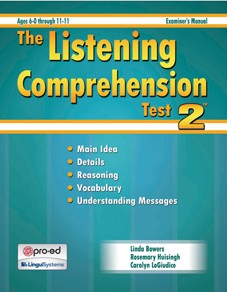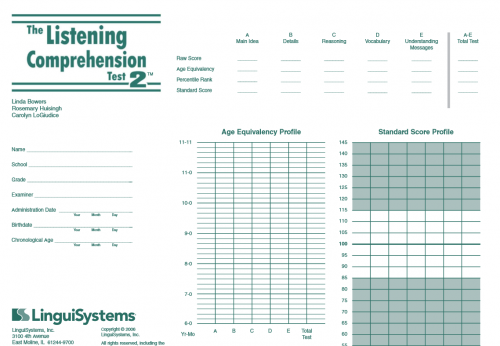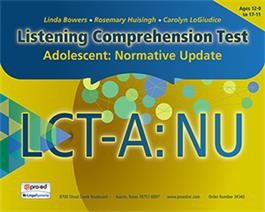Price $200.00
Contents
-

The Listening Comprehension Test 2 (LCT-2)
LCT-2 Examiner's Manual
*Not available separately (package component only)
-

The Listening Comprehension Test 2 (LCT-2)
LCT-2 Test Forms (20)
$54.00 -

The Listening Comprehension Test 2 (LCT-2)
LCT-2 Container (Vinyl Sleeve)
*Not available separately (package component only)
The Listening Comprehension Test 2—Second Edition assesses listening through natural classroom situations rather than evaluating listening through simple repetition or discrimination subtests. The tasks reveal students' strengths and weaknesses in integrated language problem solving, reasoning, and comprehension of material presented auditorily.
Because children need the basic skill of listening (receiving, attending to, interpreting, and responding to verbal messages and other cues) in order to succeed in school and in life and because classroom listening is such an integrated process, each subtest on The Listening Comprehension Test 2 require students to:
- pay careful attention to what they hear
- listen with a purpose in mind
- remember what they hear well enough to think about it
- avoid being impulsive in giving answers
- express answers verbally
The test, as closely as possible, models the type of listening required in the classroom. The student must determine what part of the message needs immediate attention, organize and understand the input, and plan appropriate responses. In order to respond, the student must integrate the communication skills of vocabulary and semantics, syntax and morphology, phonology, and thinking.
Subtests
- Subtest A: Main Idea
- The student identifies the main idea after listening to a passage read aloud by the examiner. The student must recall his background knowledge of the topic and process the overall meaning of the passage.
- Subtest B: Details
- The student listens to a passage and answers a question about the details. The student must rely on grammar, vocabulary, and the semantics of the passage to comprehend the details.
- Subtest C: Reasoning
- This subtest taps into higher-level cognitive skills. The student infers answers from information presented verbally.
- Subtest D: Vocabulary
- The student gives a one-word synonym or a descriptive definition for a word heard in a passage.
- Subtest E: Understanding Messages
- The student listens to a short message and answers two questions about it.
- Copyright 2006

 Proud to be Canadian
Proud to be Canadian
